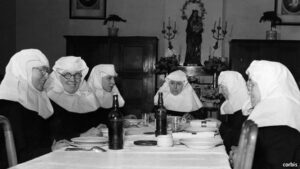When thinking of a place and a story to tell about the Marais, I thought of Victor Hugo’s house and museum at first, not too far from the famous Place des Vosges. But then I decided for a lesser-known endroit and chose to tell story of the Beguines’ Convent in Marais. This religious community used to live in the convent tucked between rue Charlemagne and rue du Fauconnier, near Village Saint Paul, during the 13th and 14th century.
The Convent Today
The medieval stones from Philippe Auguste’s city wall store the summer heat. I walk along the front of the Lycée Charlemagne and its surrounding wall until I reach rue Ave Maria. There is no visible trace of the convent anymore, only schools, and no commemorative plaque mentioning the Beguines and it’s sadly not surprising as we know very little about the women that used to live there. Fascinating story, though, I find.

Recreating the Past
I take a Polaroid picture of the little blue door that is anything but medieval but it helps stir the imagination. The Beguines were laywomen that lived in a convent behind that blue door but without surrounding walls. They lived a devout life but without taking their vows. There were noblewomen, women with children, widows, lone women with no particular birthright, and other misfits.
King Saint Louis authorized them to live as a community as long as they were not religious (!), and moved them to this location in the Marais mid-13th century. The social differences were maintained (noblewomen had better houses than those of low birth) and they answered to a mistress or two, providing them with a hierarchy. Think how surprising, even to this day, it would be to have a women-only community choosing to live outside of society and its norms but inside the city.
Marguerite Porete
During that time, there were about 400 Beguines. One of them became scandalously famous: Marguerite Porete. She penned the Miroir des âmes simples, Mirror of the simple souls, for which she was condemned and burnt alive on Place de Grève. She preached about a life with God outside the sacraments and that made her a heretic. To think a woman, or anyone, could get closer to God by gardening without going to Church was a completely novel idea and in spite of being officially burnt a few times, Porete’s forbidden book of dogma illegally traveled to England and Flanders the following centuries and spread the word.

École de Filles
In the stone above the portal to the elementary school, there is still engraved: school for girls. I don’t know if it is the same school where the daughters of the Beguines used to go. In the mid 14th century, fewer and fewer Beguines came to live there until Louis XI replaced them with the Third-Order nuns. So, next time you wander around in the Marais, do swing by those streets and think of the free-minded women that lived there in medieval Paris, because there may never have been none alike.
Article written by Clémence
Planning a trip to Paris soon? Book now a Private Tour of Le Marais!
You can also request a bespoke itinerary of Paris here:




